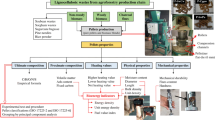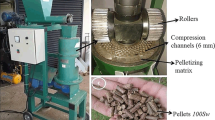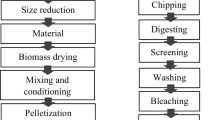Abstract
Pellets have become an important renewable energy source. Aiming to contribute for diversifying the Brazilian energy matrix, the goals of this work were to evaluate the quality of the pellets of lignocellulosic residues (Eucalyptus and corn) produced with the addition of different percentages of Kraft lignin. For the production of pellets, mixtures of wood with bark of a Eucalyptus urophylla and Eucalyptus grandis, and corn residue were used as raw material. The proportions of corn residue in the mixture were 0, 20, 25, and 30% (w/w). Except for the control (0% lignin), 2 and 5% (w/w) Kraft lignin were added to a dry mass of raw material in the 4 different mixtures. Pellets were produced in a laboratory press pelletizer with horizontal circular array. The following properties of the pellets were evaluated: proximate analysis, high heating value (HHV), elementary analysis, energy density, bulk density, diameter and length, hardness, mechanical durability, and fine content. The pellets were classified according to European marketing standards. The addition of Kraft lignin to eucalyptus and corn residue pellets contributed to improving the physical and mechanical pellet properties, as regards the bulk density, mechanical durability, and fine content, allowing the transportation of a greater amount of mass and energy, besides maintaining the integrity of the biofuels during handling and use. The mixing of eucalyptus with corn residue is an effective way to optimize properties of biomass solid fuel. The treatment with higher corn addition, in relation mechanical properties, showed a better performance in accordance with the European standards. The mechanical properties were above to 97.5%, besides that has no impact from the addition of Kraft lignin. The addition of up to 20% of corn residue has the potential to improve physical and mechanical pellet quality, with or without Kraft lignin addition. Thus, similar amounts to that of the treatment with the proportion of 80% eucalyptus and 20% corn residue can be a viable alternative to the production of pellets.
Graphical Abstract



Similar content being viewed by others
Data Availability
The datasets generated during and/or analyzed during the study are available in the Federal University of Viçosa repository for doctorate thesis and for master dissertations.
References
United States Department of Energy (2006) https://www1.eere.energy.gov/bioenergy/pdfs/corn-based_biorefinery.pdf Accessed 15 Dec 2021
Perez-Verdin G, Grebner DL, Munn IA, Sun C, Grado SC (2008) Economic impacts of woody biomass utilization for bioenergy in Mississippi. For Prod J 58:75–83
Fernandes U, Costa M (2010) Potential of biomass residues for energy production and utilization in a region of Portugal. Biomass Bioenerg 34:661–666. https://doi.org/10.1016/j.biombioe.2010.01.009
Barbosa BM, Colodette JL, Longue-Junior D, Gomes FJB, Martino DC (2014) Preliminary studies on furfural production from lignocellulosics. J Wood Chem Technol 34:178–190. https://doi.org/10.1080/02773813.2013.844167
Gillet S, Aguedo M, Petijean L, Morais ARC, da Costa LA, Łukasik RM, Anastas PT (2017) Lignin transformations for high value appliations: towards targeted modifications using green chemistry. Green Chem 19:4200–4233. https://doi.org/10.1039/C7GC01479A
Vaz S Jr (ed) (2018) Biomass and green chemistry – building a renewable pathway. Springer Nature, Cham
Food and Agriculture Organization of the United Nations (1994) International trade in non-wood forest products: an overview. Food and Agriculture Organization of the United Nations, Rome, Italy http://www.fao.org/docrep/x5326e/x5326e00.htm#Contents Accessed 26 Jun 2021
Kálmán G, Recseg K, Gaspar M, Réczey K (2006) Novel approach of corn fiber utilization. In: Twenty-Seventh Symposium on Biotechnology for Fuels and Chemicals. Humana Press, New York, pp 738–750. https://doi.org/10.1007/978-1-59745-268-7_60
Chen LJ, Xing L, Hana L (2009) Renewable energy from agro-residues in China: solid biofuels and biomass briqueting technology. Renew Sust Energ Rev 13:2689–2695. https://doi.org/10.1016/j.rser.2009.06.025
Van Dongen FEM, Van Eylen D, Kabel MA (2011) Characterization of substituents in xylans from corncobs and stover. Carbohydr Polym 86:722–731. https://doi.org/10.1016/j.carbpol.2011.05.007
Zhang Y, Ghaly AE, Li B (2012) Physical properties of corn residues. Am J Biochem Biotechnol 8:44–53. https://doi.org/10.3844/ajbbsp.2012.44.53
Dhepe P, Sahu R (2010) A solid-acid-based process for the conversion of hemicellulose. Green Chem 12:2153–2156. https://doi.org/10.1039/C004128A
Tahod AP, Dhepe PL (2014) Towards efficient synthesis of sugar alcohols from mono- and poly-saccharidies: role of metals, supports & promoters. Green Chem 16:4944–4954. https://doi.org/10.1039/c4gc01264j
Álvarez C, González A, Negro MJ, Ballesteros I, Oliva JM, Sáez F (2017) Optimized use of hemicellulose within a biorefinery for processing high value-added xylooligosaccharides. Ind Crops Prod 99:41–48. https://doi.org/10.1016/j.indcrop.2017.01.034
Barbosa BM, Lino AG, de Freitas HdeFB, de Aguiar AR, Gomes FJB, da Silva JC, Colodette JL (2018) Addition of corn fiber xylan to eucalyptus and pinus pulp and its effect on pulp bleachability and strength. Nord Pulp Pap Res J 33:414–419. https://doi.org/10.1515/npprj-2018-3060
Barbosa BM, Colodette JL, Muguet MCS, Gomes VJ, Oliveira RC (2016) Effects of xylan in eucalyptus pulp production. Cerne 22:207–214. https://doi.org/10.1590/01047760201622022102
Faostat (2015) ForesSTAT [online]. http://faostat3.fao.org/browse/F/*/E Accessed 25 Jul 2021
Grebner DL, Bettinger P, Siry JP, Boston K (2022) Forest products. In: Introduction to Forestry and Natural Resources, 2nd edn, Academic Press, pp 101–129
Saal U, Weimar H, Mantau U (2017) Wood processing residues. In: Wagemann K, Tippkötter N (eds) Biorefineries. Advances in biochemical engineering/biotechnology, vol 166. Springer, Cham https://doi.org/10.1007/10_2016_69
Brazilian Tree Industry – IBÁ (2020) Annual report of the Brazilian tree industry, base year 2020. IBÁ, Brasília, 100 pp 20
Tajuddin M, Ahmad Z, Ismail H (2016) A review of natural fibers and processing operations for the production of binderless boards. BioRes 11:5600–5617. https://doi.org/10.15376/biores.11.2.Tajuddin
Stelte W, Sanadi AR, Shang L, Holm JK, Ahrenfeldt J, Henriksen UB (2012) Recent developments in biomass pelletization - a review. BioRes 7:4451–4490
Paula LER, Trugilho PF, Rezende RN, Assis CO, Baliza AER (2011) Production and evaluation of pellets from lignocellulosic residues. Braz For Res 31:103–112. https://doi.org/10.4336/2011.pfb.31.68.273
Zamorano M, Popov V, Rodríguez ML, García-Maraver A (2011) A comparative study of quality properties of pelletized agricultural and forestry lopping residues. Renew Energy 36:3133–3140. https://doi.org/10.1016/j.renene.2011.03.020
Ahn BJ, Chang HS, Lee SM, Choi DH, Cho ST, Han GS, Yang I (2014) Effect of binders on the durability of wood pellets fabricated from Larix kaemferi C. and Liriodendron tulipifera L. sawdust. Renew Energy 62:18–23. https://doi.org/10.1016/j.renene.2013.06.038
Samuelsson R, Thyrel M, Sjöström M, Lestander TA (2009) Effect of biomaterial characteristics on pelletizing properties and biofuel pellet quality. Fuel Process Technol 90:1129–1134. https://doi.org/10.1016/j.fuproc.2009.05.007
Börcsök Z, Pásztory Z (2021) The role of lignin in wood working processes using elevated temperatures: an abbreviated literature survey. Eur J Wood Prod 79:511–526. https://doi.org/10.1007/s00107-020-01637-3
Whittaker C, Shield I (2017) Factors affecting wood, energy grass and straw pellet durability – a review. Renew Sus Energ Rev 71:1–11. https://doi.org/10.1016/j.rser.2016.12.119
Stelte W, Holm JK, Sanadi AR, Barsberg S, Ahrenfeldt J, Henriksen UB (2011) Fuel pellets from biomass: the importance of the pelletizing pressure and its dependency on the processing conditions. Fuel 90:3285–3290. https://doi.org/10.1016/j.fuel.2011.05.011
Berghel J, Frodeson S, Granstrom K, Renstrom R, Stahl M, Nordgren D, Tomani P (2013) The effects of kraft lignin additives on wood fuel pellet quality, energy use and shelf life. Fuel Process Technol 112:64–69. https://doi.org/10.1016/j.fuproc.2013.02.011
Pereira BLC, Carneiro ACO, Carvalho AMML, Vital BR, Oliveira AC, Canal WD (2016) Influence of adding kraft lignin in eucalyptus pellets properties. Floresta 46:235–242. https://doi.org/10.5380/rf.v46i2.44936
Boschetti WTN, Carvalho AMML, Carneiro ACO, Santos LC, Poyares LBQ (2019) Potential of kraft lignin as an additive in briquette production. Nord Pulp Pap Res J 34:147–152. https://doi.org/10.1515/npprj-2018-0002
Tomani P (2010) The lignoboost process. Celulose Chem Technol 44:53–58
Blake ST (1977) Four new species of Eucalyptus. Austrobaileya 1:7–9
Moura VPG, Caser RL, Albino JC, Guimarães DP, Melo JT, Comastri SA (1980) Evaluation of Eucalyptus species and provenances in Minas Gerais and Espírito Santo: partial results. Planaltina: EMBRAPA-CPAC, 104 pp
Technical Association of the Pulp and Paper Industry (2022) Atlanta: TAPPI ______TAPPI Standard. T 257 cm-85: Sampling and preparing wood for analysis ______TAPPI Standard. T 264 cm-07: Preparation of wood for chemical analysis ______TAPPI Standard. T222 cm-11: Acid-insoluble lignin in wood and pulp ______TAPPI Standard. TUM 250: Acid-soluble lignin in wood and pulp
Deutsches Institut für Normung (2022) Berlin: DIN ______DIN EN 14775: Determination of ash ______DIN EN 14918: Determination of calorific value ______DIN EN 15103: Determination of bulk density ______DIN EN 15210–1: Solid biofuels – determination of mechanical durability of pellets and briquettes – part 1: pellets ______DIN EN 15104: Determination of total content of carbon, hydrogen and nitrogen – instrumental methods ______DIN EN 15296: Conversion of analytical results from one basis to another ______DIN EN 14961–6: Solid biofuels – fuel specifications and classes – part 6: non-woody pellets for non-industrial use ______DIN EN 16127: Determination of length and diameter of pellets
Associação Brasileira de Normas Técnicas (1983) ABNT/NBR 8112: proximate analysis. Ash, volatile matter and fixed carbon content. ABNT, Rio de Janeiro
American Society for Testing Materials (2001) - ASTM. D1762–84: Standard test method for chemical analysis of wood charcoal. ASTM International, Philadelphia
Obernberger I, Thek G (2010) The pellet handbook: the production and thermal utilization of pellets. Earthscan, London, p 593
Lilliefors HW (1967) On the Kolmogorov-Smirnov test for normality with mean and variance unknown. J Am Stat Assoc 62:399. https://doi.org/10.1080/01621459.1967.10482916
Cochran WG (1950) The comparison of percentages in matched samples. Biometrika 37:256–266. https://doi.org/10.1093/biomet/37.3-4.256
Torbjörn AL, Michael F, Robert S, Mehrdad A, Mikael T (2012) Industrial scale biofuel pellet production from blends of unbarked softwood and hardwood stems—the effects of raw material composition and moisture content on pellet quality. Fuel Process Technol 95:73–77. https://doi.org/10.1016/j.fuproc.2011.11.024
Statistica (2010) StatSoft, Inc. version 10.0 (data analysis software system), http://www.statsoft.com
Karkania V, Fanara E, Zabaniotou A (2012) Review of sustainable biomass pellets production – a study for agricultural residues pellets’ market in Greece. Renew Sust Energ Rev 16:1426–1436. https://doi.org/10.1016/j.rser.2011.11.028
Demirbas A (2002) Relationships between heating value and lignin, moisture, ash and extractive contents of biomass fuels. Energy Explor Exploit 20:105–111. https://doi.org/10.1260/014459802760170420
Senyo WC, Creamer AW, Wu CF, Lora JH (1996) The use of organosolv lignin to reduce press vent formaldehyde emissions in the manufacture of wood composites. For Prod J 46:73–77
Belgacem MN, Blayo A, Gandini A (2003) Organosolv lignin a filler in inks, varnishes and paints. Ind Crop Prod 18:145–153. https://doi.org/10.1016/S0926-6690(03)00042-6
Kubo S, Kadla JF (2004) Poly(ethylene oxide)/organosolv lignin blends: relationship between thermal properties, chemical structure, and blend behavior. Macromolecules 37:6904–6911. https://doi.org/10.1021/ma0490552
Santos F, Colodette J, Queiroz JH (2013) Bioenergy and biorefinery – sugarcane and forest species. Viçosa: UFV, 551 pp
Ferreira JC (2017) Synthesis of urea-formaldehyde adhesives with the addition of kraft lignin and nanocrystalline cellulose. Ph. D. Thesis, Federal University of Viçosa, Viçosa: UFV
Santos RC, Carneiro ACO, Pimenta AS, Castro RVO, Marinho IV, Trugilho PF, Alves ICN, Castro AFNM (2013) Energy potential of species from forest management plan for the Rio Grande do Norte state. For Sci, Santa Maria 23:491–502
Brumano GC, Colodette JL, Fernandes SA, Barbosa BM, B GFJ (2020) Investigation of eucalypt and pine wood acid-soluble lignin by Py-GC-MS. Holzforschung 74:149–155. https://doi.org/10.1515/hf-2018-0219
Tabil L, Sokhansanj S (1996) Process conditions affecting the physical quality of alfalfa pellets. Appl Eng Agric 12:345–350. https://doi.org/10.13031/2013.25658
Liu CW, Sung Y, Chen BC, Lai HY (2014) Effects of nitrogen fertilizers on the growth and nitrate content of lettuce (Lactuca sativa L.). Int J Environ Res Public Health 11:4427–4440. https://doi.org/10.3390/ijerph110404427
Narra S, Tao Y, Glaser C, Gusovius HJ, Ay P (2010) Increasing the calorific value of rye straw pellets with biogenous and fossil fuel additives. Energy Fuels 24:5228–5234. https://doi.org/10.1021/ef100823b
Funding
This work was supported by the Brazilian Coordination for the Improvement of Higher Education Personnel (CAPES) (Biorefinery of Lignin Project; EMBRAPA-CAPES 2014 Joint Call).
Author information
Authors and Affiliations
Contributions
Bianca M. Barbosa—experiments for her PhD thesis and manuscript draft. Sílvio Vaz Jr.—manuscript review and submission; Bianca M. Barbosa’s thesis co-supervision. Jorge Luis Colodette—Bianca M. Barbosa’s thesis supervision. Humberto Fauller de Siqueira—manuscript review and assistance during experiment. Carlos Miguel Simões da Silva—manuscript review and assistance during experiment. Welliton Lelis Cândido—manuscript review and assistance during experiment.
Corresponding author
Ethics declarations
Consent for Publication
All authors agree with submission to BioEnergy Research, being represented by the author for correspondence.
Competing Interests
The authors declare no competing interests.
Additional information
Publisher's Note
Springer Nature remains neutral with regard to jurisdictional claims in published maps and institutional affiliations.
Statement of Novelty
The use of lignin and corn residue to improve the physical and chemical properties of eucalyptus pellets for energy generation is a novel approach. Our results show that bulk density and mechanical durability were improved.
Rights and permissions
About this article
Cite this article
Barbosa, B.M., Vaz, S., Colodette, J.L. et al. Effects of Kraft Lignin and Corn Residue on the Production of Eucalyptus Pellets. Bioenerg. Res. 16, 484–493 (2023). https://doi.org/10.1007/s12155-022-10465-7
Received:
Accepted:
Published:
Issue Date:
DOI: https://doi.org/10.1007/s12155-022-10465-7




